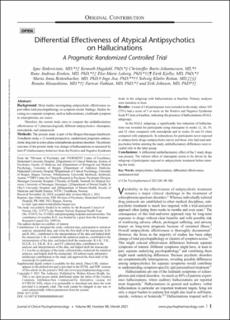| dc.contributor.author | Sinkeviciute, Igne | |
| dc.contributor.author | Hugdahl, Kenneth Jan | |
| dc.contributor.author | Bartz-Johannessen, Christoffer | |
| dc.contributor.author | Kroken, Rune Andreas | |
| dc.contributor.author | Løberg, Else-Marie | |
| dc.contributor.author | Kjelby, Eirik | |
| dc.contributor.author | Rettenbacher, maria | |
| dc.contributor.author | Joa, Inge | |
| dc.contributor.author | Reitan, Solveig Merete Klæbo | |
| dc.contributor.author | Alisauskiene, Renata | |
| dc.contributor.author | Fathian, Farivar | |
| dc.contributor.author | Johnsen, Erik | |
| dc.date.accessioned | 2021-07-07T08:03:24Z | |
| dc.date.available | 2021-07-07T08:03:24Z | |
| dc.date.created | 2021-06-07T15:18:04Z | |
| dc.date.issued | 2021 | |
| dc.identifier.citation | Sinkeviciute, I., Hugdahl, K., Bartz-Johannessen, C. et al. (2021) Differential Effectiveness of Atypical Antipsychotics on Hallucinations: A Pragmatic Randomized Controlled Trial, 41(4), 389-396 | en_US |
| dc.identifier.issn | 0271-0749 | |
| dc.identifier.uri | https://hdl.handle.net/11250/2763661 | |
| dc.description.abstract | Background
Most studies investigating antipsychotic effectiveness report either total psychopathology or symptom cluster findings. Studies focusing on a separate symptom, such as hallucinations, a hallmark symptom in schizophrenia, are scarce.
Therefore, the current study aims to compare the antihallucinatory effectiveness of 3 pharmacologically different antipsychotics: olanzapine, amisulpride, and aripiprazole.
Methods
The present study is part of the Bergen-Stavanger-Innsbruck-Trondheim study, a 12-month prospective, randomized, pragmatic antipsychotic drug trial in active-phase schizophrenia spectrum disorders. The primary outcome of the present study was change of hallucinations as measured by item P3 (hallucinatory behavior) from the Positive and Negative Syndrome Scale in the subgroup with hallucinations at baseline. Primary analyses were intention to treat.
Results
A total of 144 participants were included in the study, where 105 (72%) had a score of 3 or more on the Positive and Negative Syndrome Scale P3 item at baseline, indicating the presence of hallucinations (HALL subgroup).
In the HALL subgroup, a significantly less reduction of hallucinations was revealed for participants using olanzapine in weeks 12, 26, 39, and 52 when compared with amisulpride and in weeks 26 and 52 when compared with aripiprazole. In subanalyses for participants never exposed to antipsychotic drugs (antipsychotic-naive) and those who had used antipsychotics before entering the study, antihallucinatory differences were revealed only in the latter group.
Conclusions
A differential antihallucinatory effect of the 3 study drugs was present. The inferior effect of olanzapine seems to be driven by the subgroup of participants exposed to antipsychotic treatment before entering the study. | en_US |
| dc.language.iso | eng | en_US |
| dc.publisher | Wolters Kluwer Health, Inc. | en_US |
| dc.rights | Attribution-NonCommercial-NoDerivatives 4.0 Internasjonal | * |
| dc.rights.uri | http://creativecommons.org/licenses/by-nc-nd/4.0/deed.no | * |
| dc.subject | antipsykotika | en_US |
| dc.subject | hallusinasjoner | en_US |
| dc.title | Differential Effectiveness of Atypical Antipsychotics on Hallucinations: A Pragmatic Randomized Controlled Trial | en_US |
| dc.type | Peer reviewed | en_US |
| dc.type | Journal article | en_US |
| dc.description.version | publishedVersion | en_US |
| dc.rights.holder | © 2021 The Author(s) | en_US |
| dc.subject.nsi | VDP::Medisinske Fag: 700::Klinisk medisinske fag: 750::Psykiatri, barnepsykiatri: 757 | en_US |
| dc.source.pagenumber | 389-396 | en_US |
| dc.source.volume | 41 | en_US |
| dc.source.journal | Journal of Clinical Psychopharmacology | en_US |
| dc.source.issue | 4 | en_US |
| dc.identifier.doi | 10.1097/JCP.0000000000001403 | |
| dc.identifier.cristin | 1914233 | |
| cristin.ispublished | true | |
| cristin.fulltext | original | |
| cristin.qualitycode | 1 | |

